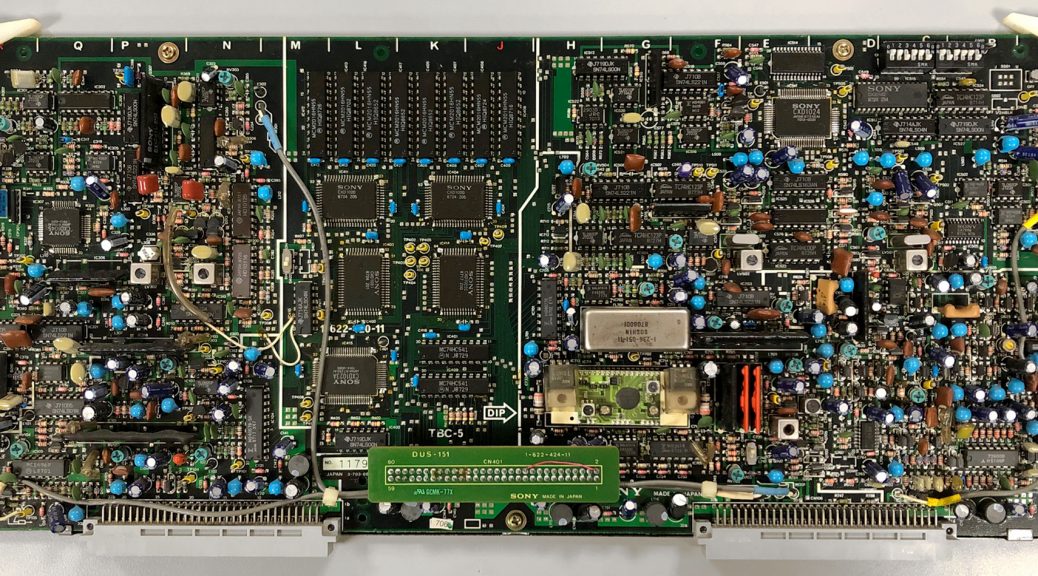The video digitization system in Duke Libraries’ Digital Production Center utilizes many different pieces of equipment: power distributors, waveform and vectorscope monitors, analog & digital routers, audio splitters & decibel meters, proc-amps, analog (BNC, XLR and RCA) to digital (SDI) converters, CRT & LCD video monitors, and of course an array of analog video playback decks of varying flavors (U-matic-NTSC, U-matic-PAL, Betacam SP, DigiBeta, VHS-NTSC and VHS-PAL/SECAM). We also transfer content directly from born-digital DV and MiniDV tapes.

One additional component that is crucial to videotape digitization is the Time Base Corrector (TBC). Each of our analog video playback decks must have either an internal or external TBC, in order to generate an image of acceptable quality. At the recent Association of Moving Image Archivist’s Conference in Baltimore, George Blood (of George Blood Audio/Video/Film/Data) gave a great presentation on exactly what a Time Base Corrector is, appropriately entitled “WTF is a TBC?” Thanks to George for letting me relay some of his presentation points here.
A time base is a consistent reference point that one can utilize to stay in sync. For example, The Earth rotating around the Sun is a time base that the entire human race relies on, to stay on schedule. A grandfather clock is also a time base. And so is a metronome, which a musical ensemble might use to all stay “in time.”
Frequency is defined as the number of occurrences of a repeating event per unit of time. So, the frequency of the Earth rotating around the Sun is once per 24 hrs. The frequency of a grandfather clock is one pendulum swing per second. The clock example can also be defined as one “cycle per second” or one hertz (Hz), named after Heinrich Hertz, who first conclusively proved the existence of electromagnetic waves in the late 1800’s.

But anything mechanical, like grandfather clocks and videotape decks, can be inconsistent. The age and condition of gears and rods and springs, as well as temperature and humidity, can significantly affect a grandfather clock’s ability to display the time correctly.
Videotape decks are similar, full of numerous mechanical and electrical parts that produce infinite variables in performance, affecting the deck’s ability to play the videotape’s frames-per-second (frequency) in correct time.
NTSC video is supposed to play at 29.97 frames-per-second, but due to mechanical and electro-magnetic variables, some frames may be delayed, or some may come too fast. One second of video might not have enough frames, another second may have too many. Even the videotape itself can stretch, expand and contract during playback, throwing off the timing, and making the image wobbly, jittery, too bright or dark, too blue, red or green.
A Time Base Corrector does something awesome. As the videotape plays, the TBC stores the unstable video content briefly, fixes the timing errors, and then outputs the corrected analog video signal to the DPC’s analog-to-digital converters. Some of our videotape decks have internal TBCs, which look like a computer circuit board (shown below). Others need an external TBC, which is a smaller box that attaches to the output cables coming from the videotape deck (shown above, right). Either way, the TBC can delay or advance the video frames to lock them into correct time, which fixes all the errors.

An internal TBC is actually able to “talk” to the videotape deck, and give it instructions, like this…
“Could you slow down a little? You’re starting to catch up with me.”
“Hey, the frames are arriving at a strange time. Please adjust the timing between the capstan and the head drum.”
“There’s a wobble in the rate the frames are arriving. Can you counter-wobble the capstan speed to smooth that out?”
“Looks like this tape was recorded with bad heads. Please increase gain on the horizontal sync pulse so I can get a clearer lock.”
Without the mighty TBC, video digitization would not be possible, because all those errors would be permanently embedded in the digitized file. Thanks to the TBC, we can capture a nice, clean, stable image to share with generations to come, long after the magnetic videotape, and playback decks, have reached the end of their shelf life.


